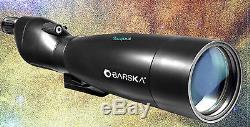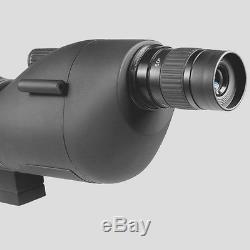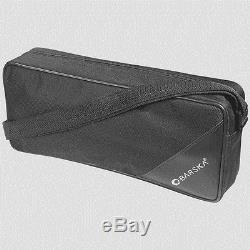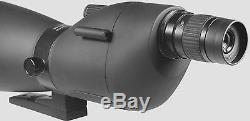Barska 30-90x90 (Over 3-1/2 Inches in Diameter!)Waterproof Spott. Scope CO11218





This is a spotting scope with some extra kick. The Barska Colorado Scope features a powerful zoom magnification range image that runs from from 30x to 90x power, with a straight-body design for head-on viewing. The massive 90mm (Over 3-1/2) ocular lens ensures that you'll get a vivid and bright image every time. Barska CO11218 has a blued outer lens, with fully coated lenses throughout.
The optics and inner workings of the spotting scope are protected by the watertight outer housing. This waterproof spotting scope is ideal for long-distance observation and shooting. A spotting scope is a small telescope that has been modified for use by day. A spotting scope differs from an astronomical telescope in several important ways.
First, a spotting scope always produces an upright image whereas a telescope used in astronomy may produce a reversed image or even an upside down image (not a problem for astronomy). Second, a spotting scope is much smaller in size than an astronomical telescope, mainly for the sake of portability.
Third, a spotting scope is a lower magnification instrument than a telescope, since the atmosphere by day does not allow the high magnifications used in astronomy. Fourth, a spotting scope is mounted on an ordinary photo tripod, but a telescope for astronomy requires a very specialized mount, often unsuitable for daytime use. Lastly, many, if not most, spotting scopes are waterproof and fogproof - a rare feature in an astronomical telescope. Spotting scopes are used anytime you need more magnification than a binocular provides.
Spotting scopes are widely used for birding, surveillance, hunting, and viewing landscape, wildlife, ships and other distant objects. Spotting scopes are also used for scoring targets on rifle, pistol and archery ranges and they can also be used to some astronomy. Last, but not least, spotting scopes are also used to take long distance pictures with a variety of cameras. Most spotting scopes are labeled with three numbers. The first two numbers represent the magnification range and the last number is always the size of the front lens.
For a 15-45x60 model, then, you have a spotting scope with a zoom magnification range of 15-45x with a front lens of 60mm diameter. Spotting scopes begin in magnification where conventional binoculars stop. The higher magnifications offered by a spotting scope allow you to view birds, wildlife, scenery and other objects that are well beyond the range of a conventional binocular. However, there are limits to magnification. Two things determine how much magnification you can use in a spotting scope.
The first is the atmosphere. You must always factor in the seeing conditions of the atmosphere when using a spotting scope. Heat waves, dust, humidity, glare, wind and air currents during the day all reduce image quality and the greater the magnification, the more drastic the reduction in image quality. Simply put, there will be days when anything over 30x will appear as mush, but there will also be those clear, calm days when you can use 60x to good advantage. In general, high altitudes and dry climates favor high magnification whereas wet, humid, low-altitude climates discourage high magnification.Very few locations, however, allow you to use more than 60-80x during the day, so most spotting scopes stop at 60x. The atmosphere, for the same r eason, also limits how much detail you can see at great distances.
Seeing tiny detail, such as a person's facial features, at a mile or more through an ocean of turbulent, ever-moving air is simply not possible, no matter how much magnification you use or no matter how large or expensive the instrument. Spotting scopes are great, but they can't work miracles.On the other hand, it is quite possible to view large objects such as ships at this distance, though the image may be blurry or wavy. The second major limit on magnification is the optical system of the spotting scope, itself. Regardless of the model, there will always be some drop off in image quality as magnification goes up.
This is determined somewhat on the design and size of the scope, but primarily on the quality of the optical system. Here you get what you pay for in a very visible way.
Inexpensive spotting scopes, regardless of size or type, lose image quality quickly as magnification goes up, but premium grade scopes lose very little in image quality, even at the highest magnification. Be prepared to pay, however, if you want a spotting scope that is as sharp at 60x as it is at 20x. Only a handful of very expensive spotting scopes are capable of this. Most observing with a spotting scope, though, is done at lower magnifications, usually around 30x-40x. This is more than enough for most applications and all but the cheapest model will produce reasonable images in this magnification range.
The item "Barska 30-90x90 (Over 3-1/2 Inches in Diameter! Scope CO11218" is in sale since Thursday, July 24, 2014. This item is in the category "Sporting Goods\Hunting\Scopes, Optics & Lasers\Spotting Scopes". The seller is "bluequasar17" and is located in Pewaukee, Wisconsin. This item can be shipped worldwide.
- Type: Spotting Scope
- Max Magnification: 30-90X
- Use: Astronomy
- Features: Image Stability
- Aperture: 90 mm
- Brand: Barska Optics
- Model: GLADIATOR AD10606
- MPN: AD10606
- Body Type: Straight
- Coating: Multi-Coated
- Eyepiece Type: Zoom Eyepiece
- Waterproof: With Waterproof

